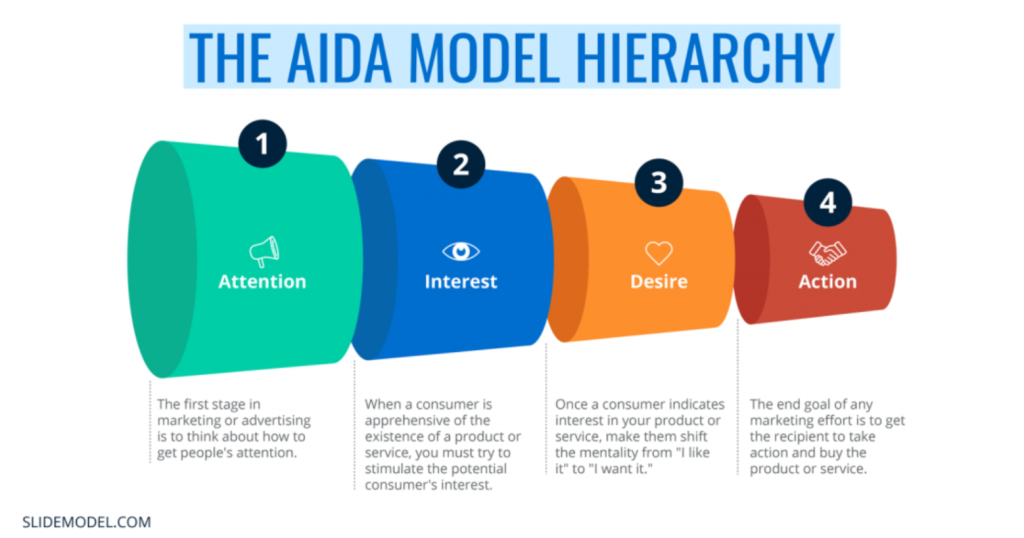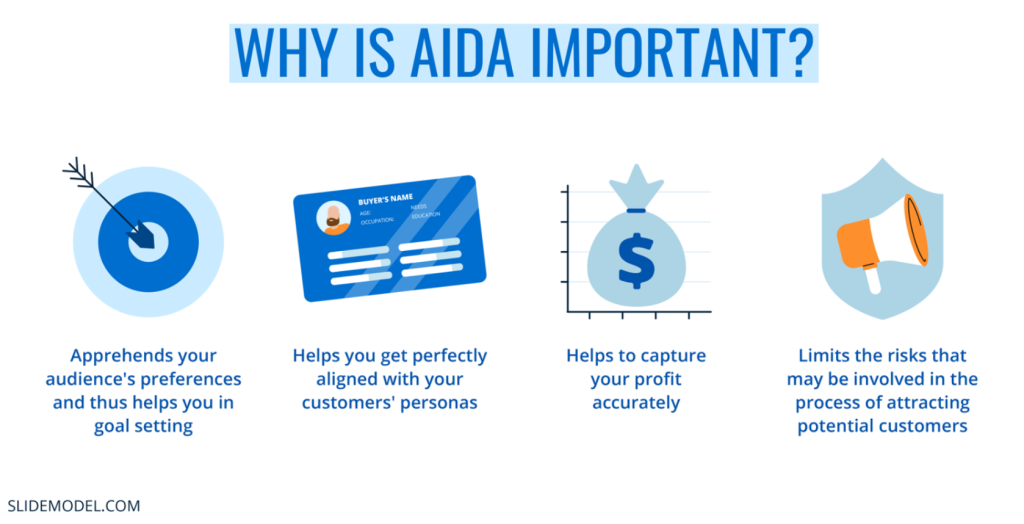The AIDA model is a classic marketing framework that guides potential customers through their buying journey. Developed in 1898 by St. Elmo Lewis, it originally described the process a salesperson must follow to lead a prospect to a successful sale.
WHAT IS THE AIDA MODEL?
The AIDA model describes a series of steps that customers follow when making purchase decisions. The stages consist of Awareness, Interest, Desire, and Action.
This framework typically aligns with the customer or marketing funnel and serves as a blueprint for developing effective marketing strategies that drive conversions and sales.

WHAT DOES AIDA STAND FOR?
The AIDA approach, over 125 years old, is perhaps the oldest acronym in marketing. Multiple versions of this framework exist today, all falling under the broad umbrella of “Hierarchy of Effects Models,” which aim to understand potential customer behaviour to persuade them to take action on a brand, product, or service.
AIDA stands for Awareness, Interest, Desire, and Action.
Awareness: People become aware of a brand, product, or service. This awareness typically stems from advertising, which captures attention by creating a buzz.
Interest: As people become familiar with the brand and learn more about the product or service’s benefits and how it fits their lifestyle, their interest grows.
Desire: People develop a connection with the product, thus transitioning from mere interest to a more emotional inclination of wanting or “needing” it.
Action: Finally, people decide to interact with the product or service by taking action. This could include signing up for a trial, subscribing to an email, making a booking or completing a purchase.

HOW TO APPLY AIDA TO DIGITAL MARKETING
Digital advertisers and marketers often find it challenging to focus on the strategic big picture when most of their time is spent navigating through an abundance of intricate and overwhelming details.
However, having a view of the broader perspective is crucial, especially because digital marketing today demands alignment between strategy, creative, and performance to achieve impact. The AIDA model provides a structured approach to help marketers guide potential customers through the buying journey.
Awareness
The first step in the AIDA model is to raise awareness and capture the attention of potential customers. This involves making them aware of your brand, product, or service through content forms with mass reach, such as advertisements, videos, podcasts, and social media.
However, with people exposed to thousands of ads daily, being able to cut through the noise is essential. The goal is to be disruptive enough to capture attention without being annoying. Thumb-stopping content, especially when unexpected, can be particularly effective in paid media campaigns.
On the SEO front, brands should focus on informational content at this stage. This is because someone getting to know your brand at the awareness stage will want to read something vastly different from someone who is ready to purchase or comparing products. Creating content hubs or “content clusters” can help structure content for various stages of the funnel.
For example, if your target audience is small business owners, in addition to creating blog content about your product’s features and benefits, consider producing content that offers insights on various business topics. This could range from advice on leading small teams to local market insights and updates on regulations affecting small businesses. The key aim is to reach your target audience in the context of their business and gain awareness through content that is useful to them.
Interest
After raising awareness, you need to pique their interest. Marketers must ensure that the customer’s attention does not wane over time. You can build interest by understanding the wants and needs of the target market and focusing your information on how your product meets those wants and needs.
Not everyone whose awareness you gain will develop an interest in your product or service, which is why the funnel starts to narrow.
Engagement can include anything from entertaining videos and educational articles to informational blogs. This stage focuses on those who move further down the funnel from the awareness stage and are expecting more product-based information.
Highlighting the unique selling propositions (USPs) and product benefits can be instrumental in sustaining interest. When running campaigns at this stage, interest-based tactics in the AIDA model include encouraging prospects to visit your website, A/B testing call-to-action (CTA) messages and using retargeting to help nudge people further down the funnel toward conversion.
Desire
As you build your customer’s interest, you have to tell them how your product or service can help them in real ways. The desire stage of the funnel often overlaps with the interest phase. While the interest stage encourages marketers to consider the functional and logical aspects of messaging during campaign development, the desire stage emphasises creative and emotional appeal.
Building desire involves convincing your audience that your product or service can address their problems or fulfil their needs. This stage focuses on highlighting benefits and differentiating your offerings from competitors. Testimonials and case studies are powerful tools for fostering desire. For instance, sharing a customer success story can help potential customers envision their success with your product.
The key is to make users believe that your product is the best solution for them. On-site reviews, case studies, and customer testimonials are some of the tactics that can help enhance the bottom-of-funnel experience for your audience and improve conversion rates.
Action
Finally, we reach the bottom of the funnel where our focus needs to be on getting customers to convert. At this stage of the journey, your customers know who you are, know what product they want, and they want to know what you can offer them.
This presents marketers with an opportunity to offer any pricing promotions on paid search, or really focus on hyper-targeting across social media to get customers thinking about decision making. Urgency based tactics that prompt immediate action can prove to be effective in this context.

Expansions to the AIDA model
Over the years, the AIDA model has been expanded to include additional elements such as:
Retention: The original AIDA model did not account for retaining a customer after purchase. But more recent models in advertising and marketing theorise that ensuring customer satisfaction post-purchase will encourage repeat business and future leads.
Targeting: As marketers have gained more access to data sourced from user interactions with search engines, websites, and social media we have seen several opportunities emerge that allow ads to be targeted specifically to the interests of potential customers based on their interests, attitudes and browsing habits.
Satisfaction: Another development in the post-purchase part of the buying journey where marketers focus on delivering excellent customer service to ensure timely delivery and meet customer expectations, which aids retention and future sales.

The AIDA model is a foundational marketing framework but, on the flipside, there is extraordinarily little empirical evidence that proves the AIDA model’s effectiveness.
Critics argue that the model is outdated, as digital complexity makes purchase decisions non-linear. For example, with paid search, ‘interest’ does not follow ‘awareness’ but rather precedes it.
The AIDA model is best treated as a solid starting point, a framework that allows marketers to look at the phases in which advertising influences brand choice. But those using it need to be cautious about treating it as a universal approach.


